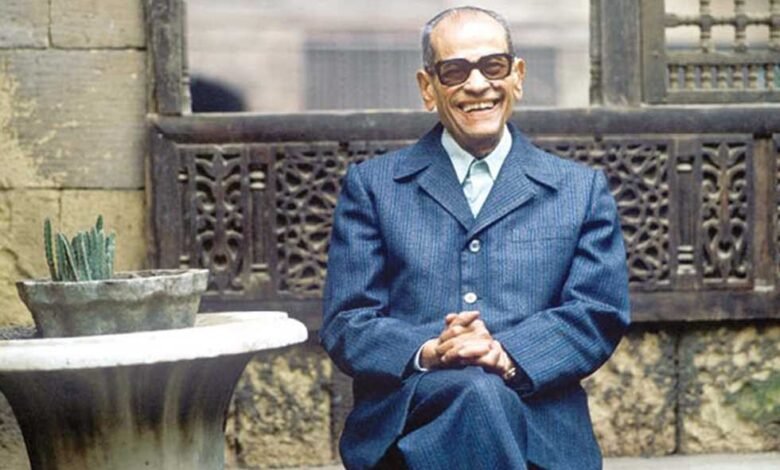“Costume de hoje” .. Naguib Mahfouz morreu em 30 de agosto de 2006

Omar, Naguib Mahfouz, tinha 7 anos quando a Revolução de 1919 estabeleceu e lembrou -a mais tarde em “Entre The Kasserine”, a primeira parte de sua trilogia e ingressou na Universidade do Cairo em 1930 e obteve um Bachelor of Philosophy, e começou a preparar sua tese de mestrado sobre a “beleza in islâmica” e então Fiz um teatro de suas idéias imortal, um modelo da composição humana, social e espiritual da personalidade egípcia e inspirou o espírito e a atmosfera egípcios em suas obras, que ocorre a maior parte de seus eventos no Egito antigo.
Naguib Mahfouz was born on December 11, 1911, and he left the “Today’s costume” on August 30, 2006 and between them a long journey that exceeded 50 years of creativity, commitment, discipline and order, all of which are factors that put it on the summit, not only as a pioneer of modern Arabic novel, but one of its most deep book and induction of history and an inspiration for his lessons, and he who drew amazing pen images that expressed the Sociedade egípcia em vários estágios com uma profundidade que não estava disponível. Entre os sociólogos, a política e a história, usando uma linguagem bonita e elegante, mas é rigoroso como a linguagem da ciência e permaneceu regularmente pelo último minuto de sua vida, seja no sono ou acordando, em momentos de escrita e datas de amigos, e até a data do cigarro e uma xícara de café até que essa regularidade apareça como uma chave para a sua criação criativa.
Mahfouz foi o primeiro árabe a manter o Prêmio Nobel de Literatura, e transformou a maioria de seus trabalhos em séries de televisão e rádio, filmes cinematográficos e obras teatrais e juntou -se ao corpo do governo para trabalhar como um parlamentar da Ministério da Ministério de 1938 a 1945 e depois diretor da Bom da Ministério da Ministério até 194. Ministry of Culture To monitor artistic works, and in 1960 he worked as general manager of the Film Support Foundation and then an advisor to the General Fine, Radio and Television Corporation and the last government position his job was the Chairman of the Board of Directors of the General Cinema from 1966 to 1971, then he retired and became one of the Book of Al -Ahram and married in his period of stopping writing after the July 1952 revolution from Mrs. Attia Allah Ibrahim, and he hid the news His marriage with his preoccupation with the patronage of his mother, his widow sister and her children, and during that period his income increased his work in writing the scenarios of films and he had enough money to establish a family that was not known as the news of his marriage until after 10 years when one of his daughters or Fatum and Fatima quarreled with a colleague in the school, so the poet Salah Jaheen knew about the matter of the student’s father, and A notícia se espalhou entre o conhecimento e a escrita começou em meados dos anos trinta. Ele publica suas histórias curtas na revista “Al -Rrisala” desde 1939 e publicou seu primeiro romance, “The Tiper of Fate”, que apresentou seu conceito sobre realismo histórico, depois publicou “The Tuaiba e Radubus”, encerrando uma trilogia histórica que a maioria dos faraohs e da partida de 1945 “” “Khan al -Khalili” e “Zaqq al -Madq” Realismo psicológico no romance “The Mirage” e depois retornou ao realismo social com “começo e fim” e “Cairo Triple”. E ele foi para Al -Ramazi no romance “Al -Shuza” e “Os Filhos do Nosso Bairro”, que causaram fortes reações e foi a razão para incitar sua tentativa de assassinato.
In an advanced stage of his literary career, he went to new concepts such as writing on the boundaries of the fantasy, as in his novel, “The Harafish and the Nights of the Thousand Nights” and his book “The Sufi Dhouf and Dreams” as in (Echoes of the CV, and the dreams of the recovery period) who were called by poetic intensification and the detonation of the language and the world, and Mahfouz stopped writing after the “trilogy”, and he entered into a state of silence, Social realism to symbolic realism, then the pyramids published his novel “The Children of Our Neighborhood” in 1959, in which Naguib surrendered to the temptation of the use of major tales from the history of humanity in reading the political and social moment of post -revolution Egypt to ask a question to the men of the revolution about the path they want to follow the “road of Fatwas ou a rota Harafish “, e o romance levantou fortes reações que o levaram a interromper sua publicação e a direção de não publicá -la no Egito. Seu lançamento em 1967 pelo DAR libanês da literatura libanesa, e fortes reações vieram das interpretações diretas dos símbolos religiosos no romance, e seus personagens como: “Al -Jablawi, Adham, Idris, Jabal, Rafaa, Qasim e Arafa” e a morte de Jablawi, na qual havia um choque doutrinário a muitos religiosos.
Al -Nasrafi al -Ahram parou devido à objeção de corpos religiosos ao que eles descreveram como “seu comprimento no eu divino” e o romance completo não foi publicado no Egito durante esse período, e o assunto exigia 8 anos até que pareça completo na edição da Liberature House que eu imprimi em Beirut em 1967 e nas crianças de uma vizinhança em Egypt em Egypt, que estava rek. 1995 Ele foi esfaqueado no pescoço por um jovem que decidiu assassiná -lo para acusá -lo de descrença sobre a religião por causa de seu romance controverso. É relatado que o investigador que perguntou ao jovem por que ele queria matá -lo disse: “Porque ele é um infiel e escreveu uma narração na qual incorporava a personalidade de Deus e dos profetas”. Então o investigador perguntou a ele: você leu sozinho, e o jovem respondeu que não leu ou escreveu.




